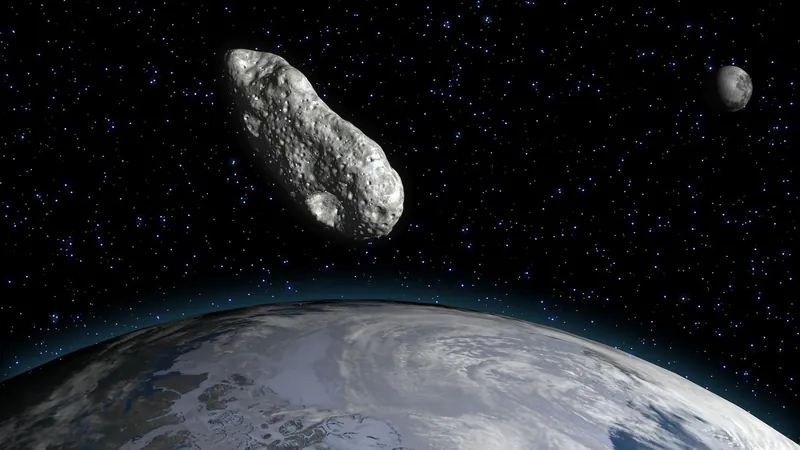
James Webb Telescope Takes Emergency Aim at 'City-Killer' Asteroid 2024 YR4 Before 2032 Encounter
2025-03-31
Author: Liam
James Webb Telescope Takes Emergency Aim at 'City-Killer' Asteroid 2024 YR4 Before 2032 Encounter
In a groundbreaking initiative, the James Webb Space Telescope (JWST) has undertaken its vital first observations of the notorious "city-killer" asteroid 2024 YR4, which is set to make an alarming close call with Earth and the moon in December 2032. This urgent assessment was made possible by an allocation of emergency observation time granted to a coalition of international astronomers earlier this year.
The initial findings reveal that 2024 YR4 might be larger and rockier than prior assessments from ground-based telescopes indicated. Despite initial fears regarding a possible impact, NASA has confirmed that the asteroid poses no threat to Earth, with a zero percent chance of collision. However, researchers caution that a direct hit on the moon remains a possibility.
According to the researchers' preliminary report, although 2024 YR4’s likelihood of striking Earth on December 22, 2032, has been eliminated, there continues to be a small probability of impacting the moon. A follow-up observation is planned for May 2025, before the asteroid vanishes into the depths of our solar system for years.
The Nature of a 'City-Killer' asteroid
Discovered in December 2024, asteroid 2024 YR4 measures approximately 180 feet (55 meters) in diameter—about the same height as the Leaning Tower of Pisa. If it were to collide with Earth, the potential devastation could be catastrophic, producing an explosion equivalent to 500 Hiroshima bombs.
Earlier predictions placed its chance of impacting Earth in 2032 at a staggering 3.1%, the highest recorded for an object of this size. Subsequently, NASA refined this estimate to zero. During this period of uncertainty, the European Space Agency (ESA) announced it would use JWST’s emergency observation time to explore the asteroid’s size and trajectory.
JWST's state-of-the-art infrared sensors are key to these studies, allowing astronomers to detect the heat emitted by the asteroid, thus providing crucial data about its size and composition. Unlike ground-based telescopes that rely on visible light, JWST can see beyond reflective sunlight, revealing the asteroid's true nature.
Enhanced Observations
On March 26, JWST observed asteroid 2024 YR4 rotating over a five-hour period, with a rotation taking roughly 20 minutes. These observations converted the asteroid's brightness data into mid-infrared wavelengths, alongside analyzing its position relative to the sun and JWST. As a result, the asteroid is now estimated to measure about 200 feet (60 meters) in diameter, suggesting it may also be cooler than expected, further indicating a rockier composition.
Potential Eye on a Lunar Strike
While 2024 YR4’s dimensions and hardness may lean heavily towards non-threatening metrics for Earth, researchers have identified a 2% chance of it impacting the moon in 2032, an event that could provide unique observational benefits. According to Andrew Rivkin, an astronomer at Johns Hopkins University, witnessing a known asteroid graze the lunar surface would mark a historic moment for lunar researchers.
Despite the alarming nature of an impact, any collision with the moon would be inconsequential for Earth, given our celestial neighbor's resilience to frequent meteor strikes. However, monitoring such an event from a scientific perspective would yield vital insights into lunar crater formation—an unprecedented opportunity that astrobiologists, astronomers, and planetary scientists worldwide are eagerly anticipating.
As we await the second series of JWST observations, the ongoing study of asteroid 2024 YR4 continues to be a focal point of astronomical research, keeping both scientists and the public on the edge of their seats. Will we witness a moon impact, and what new discoveries will it unveil? Stay tuned for updates from the frontiers of space exploration!









 Brasil (PT)
Brasil (PT)
 Canada (EN)
Canada (EN)
 Chile (ES)
Chile (ES)
 Česko (CS)
Česko (CS)
 대한민국 (KO)
대한민국 (KO)
 España (ES)
España (ES)
 France (FR)
France (FR)
 Hong Kong (EN)
Hong Kong (EN)
 Italia (IT)
Italia (IT)
 日本 (JA)
日本 (JA)
 Magyarország (HU)
Magyarország (HU)
 Norge (NO)
Norge (NO)
 Polska (PL)
Polska (PL)
 Schweiz (DE)
Schweiz (DE)
 Singapore (EN)
Singapore (EN)
 Sverige (SV)
Sverige (SV)
 Suomi (FI)
Suomi (FI)
 Türkiye (TR)
Türkiye (TR)
 الإمارات العربية المتحدة (AR)
الإمارات العربية المتحدة (AR)